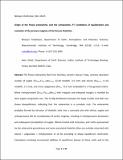| dc.contributor.author | Sheth, Hetu | |
| dc.contributor.author | Chatterjee, Nilanjan | |
| dc.date.accessioned | 2017-03-09T21:03:15Z | |
| dc.date.available | 2017-03-09T21:03:15Z | |
| dc.date.issued | 2015-03 | |
| dc.date.submitted | 2014-08 | |
| dc.identifier.issn | 0010-7999 | |
| dc.identifier.issn | 1432-0967 | |
| dc.identifier.uri | http://hdl.handle.net/1721.1/107268 | |
| dc.description.abstract | The Powai ankaramite flow from Mumbai, western Deccan Traps, contains abundant crystals of augite (En[subscript 59–47]Fs[subscript 10–14]Wo[subscript 27–42], 22–40 modal %, 3–5 mm) and olivine (Fo[subscript 84–74], 11–16 modal %, 1–2 mm), and minor plagioclase (An[subscript 71], ~0.5 mm) embedded in a fine-grained matrix. Minor orthopyroxene (En[subscript 79–77]Fs[subscript 16–19]Wo[subscript 5–4]) with irregular and embayed margins is mantled by thick augite overgrowth rims. The Fe–Mg distribution between the large crystals and bulk rock shows disequilibrium, indicating that the ankaramite is a cumulate rock. The ankaramite probably formed by the intrusion of tholeiitic melt into a cumulate pile with olivine, augite, and orthopyroxene left by the crystallization of earlier magmas, resulting in orthopyroxene dissolution and subsequent precipitation of augite. Olivine-hosted melt inclusions and melts represented by the ankaramite groundmass and some associated tholeiitic dikes are multiply saturated with olivine + plagioclase + clinopyroxene at ≤6 kb according to phase equilibrium constraints. Calculations involving incremental addition of equilibrium phases to these melts and to the common aphyric tholeiites of the voluminous Ambenali and Mahabaleshwar Formations show that their primary magmas (wt% SiO[subscript 2]: 48–50, MgO: 9.8–11.8, and FeO: 7.2–7.9, and Mg# 70–74) last equilibrated with spinel lherzolite at ~8–13 kb (~30–49 km depths) and ~1268–1332 °C, and trace element considerations indicate ≤15 % batch melting of mantle. These tholeiitic primary magmas then underwent olivine gabbro fractionation in upper crustal magma chambers at depths ≤23 km. The minimum depth of equilibration of the primary magmas is shallower than the present-day Moho in the Mumbai area based on seismological data, indicating localized mantle upwelling and lower crustal interactions previously inferred from the Nd–Sr isotopic ratios and other geochemical characteristics of the ankaramite and associated tholeiites. | en_US |
| dc.publisher | Springer Berlin Heidelberg | en_US |
| dc.relation.isversionof | http://dx.doi.org/10.1007/s00410-015-1125-8 | en_US |
| dc.rights | Article is made available in accordance with the publisher's policy and may be subject to US copyright law. Please refer to the publisher's site for terms of use. | en_US |
| dc.source | Springer Berlin Heidelberg | en_US |
| dc.title | Origin of the Powai ankaramite, and the composition, P–T conditions of equilibration and evolution of the primary magmas of the Deccan tholeiites | en_US |
| dc.type | Article | en_US |
| dc.identifier.citation | Chatterjee, Nilanjan, and Hetu Sheth. “Origin of the Powai Ankaramite, and the Composition, P–T Conditions of Equilibration and Evolution of the Primary Magmas of the Deccan Tholeiites.” Contributions to Mineralogy and Petrology 169.3 (2015): n. pag. | en_US |
| dc.contributor.department | Massachusetts Institute of Technology. Department of Earth, Atmospheric, and Planetary Sciences | en_US |
| dc.contributor.mitauthor | Chatterjee, Nilanjan | |
| dc.relation.journal | Contributions to Mineralogy and Petrology | en_US |
| dc.eprint.version | Author's final manuscript | en_US |
| dc.type.uri | http://purl.org/eprint/type/JournalArticle | en_US |
| eprint.status | http://purl.org/eprint/status/PeerReviewed | en_US |
| dc.date.updated | 2016-05-23T12:10:29Z | |
| dc.language.rfc3066 | en | |
| dc.rights.holder | Springer-Verlag Berlin Heidelberg | |
| dspace.orderedauthors | Chatterjee, Nilanjan; Sheth, Hetu | en_US |
| dspace.embargo.terms | N | en |
| mit.license | PUBLISHER_POLICY | en_US |
